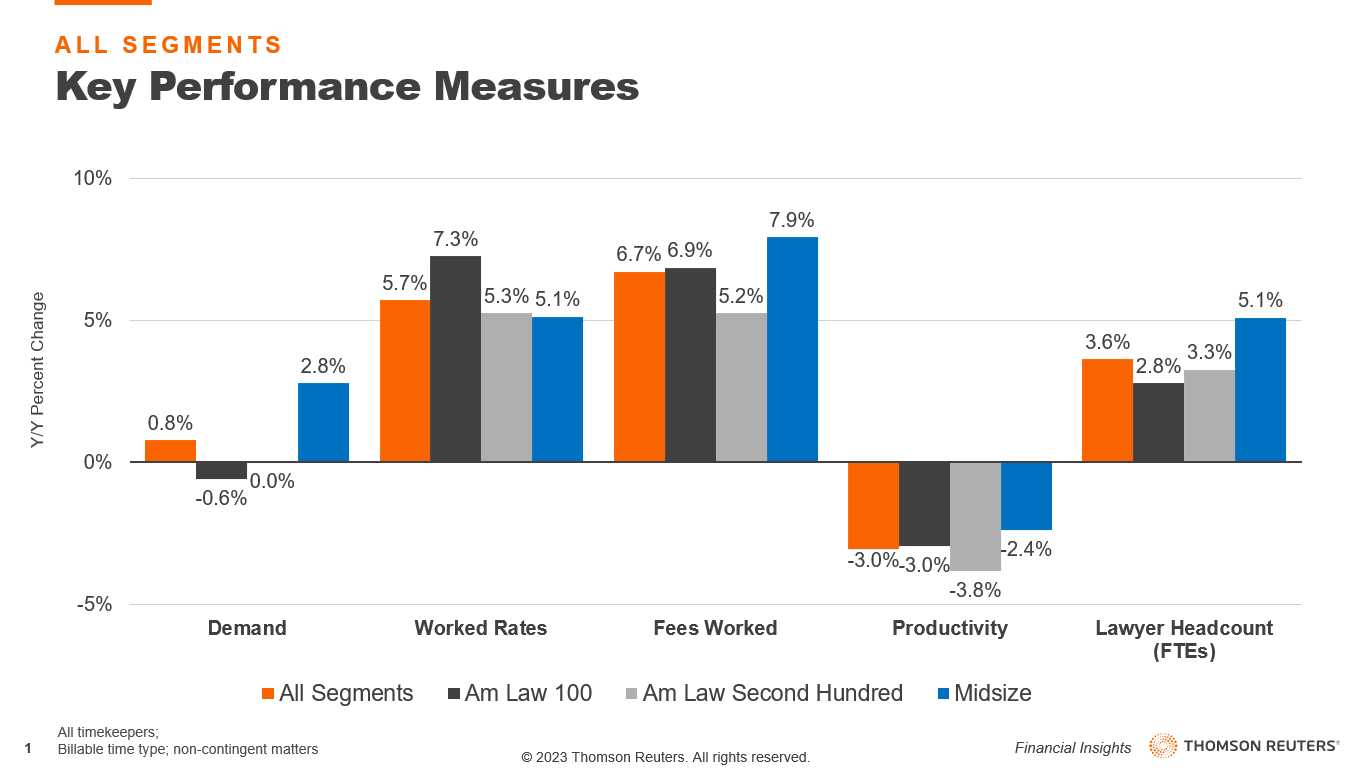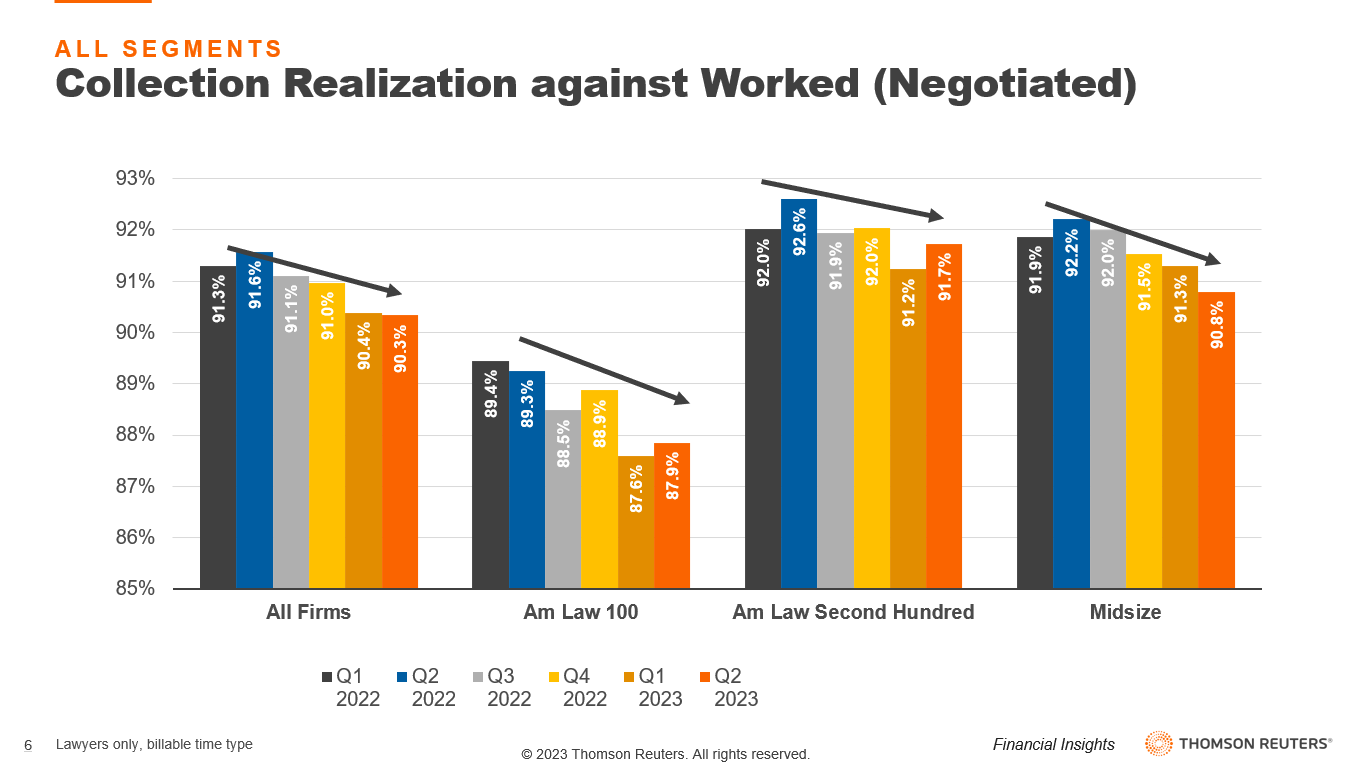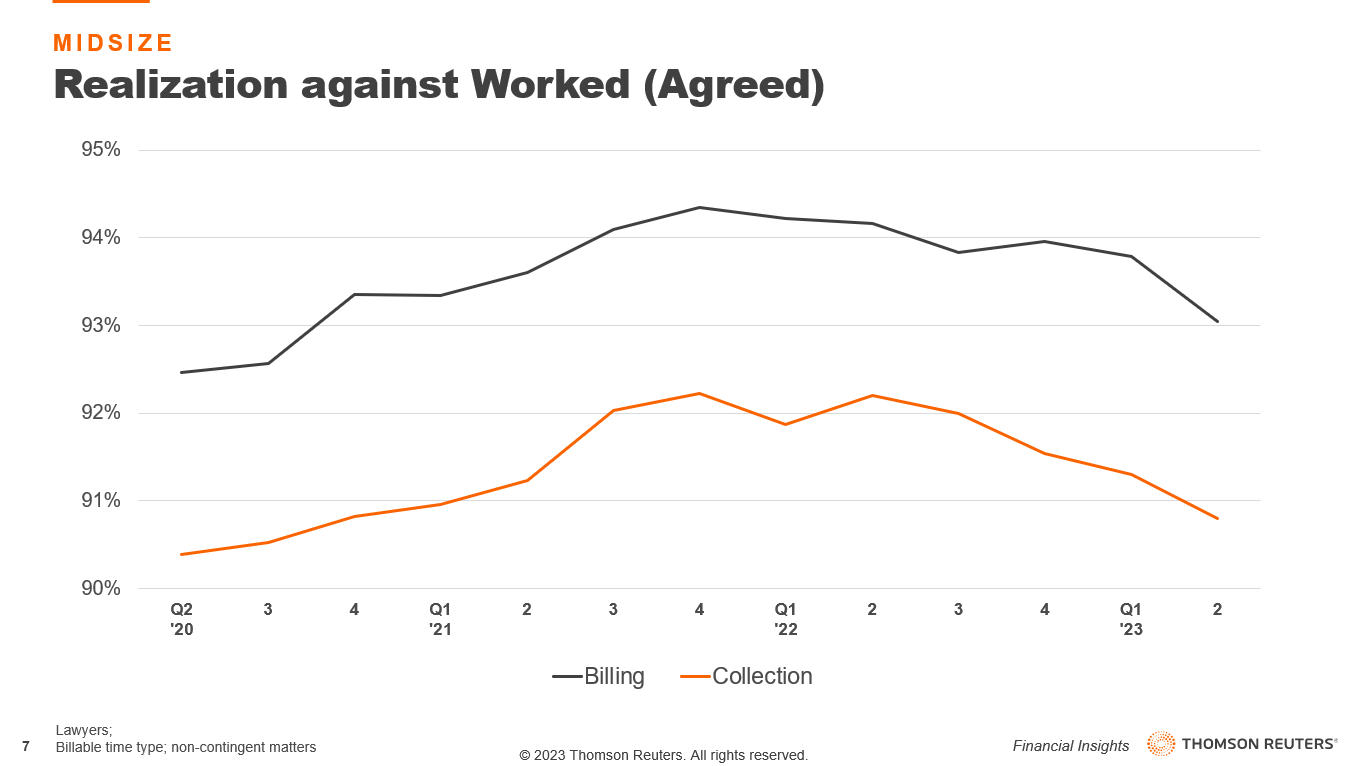As our examination of the performance of the Midsize law firm segment at the midpoint of this year continues, we look at how these firms are managing the delicate balancing act between rising rates and falling realization
By many measures, 2023 has been a banner year for Midsize law firms, which continues an impressive run that began last year.
The segment continues to lead the market for demand growth. Even in the face of large headcount growth figures, productivity declines have been modest compared to the rest of the legal industry. And perhaps most notably, Midsize law firms have gotten much more aggressive this year when it comes to growing their worked rates.

Midsize law firms ended 2022 with worked rates growing by 3.8% — worked rates being the rates clients agree to pay to engage a new matter. Fast forward just six months and the average Midsize law firm has seen their worked rates grow by 5.1%. That is impressive acceleration from a segment that has historically been pretty conservative in pushing rate increases.
It’s worth noting that the Midsize law firm segment still resides in third place out of three segments in terms of rate growth, but it is on the heels of the Am Law Second Hundred after trailing by a full percentage point’s worth of rate growth at the end of last year (3.8% for Midsize firms compared to 4.8% for Am Law Second Hundred firms).
Further, Midsize law firms do not appear to be paying a demand penalty for raising their rates. As discussed earlier in this series, Midsize law firms saw demand for their services grow by an average of 2.8% through the midpoint of the year, well ahead of the other segments — growth that was largely driven by counter-cyclical practices. The confluence of increasing demand and accelerating rate growth has put Midsize law firms into an enviable position in terms of their potential revenue picture.
An under-discussed but valuable metric included in our key performance indicators is fees worked, which is essentially an analogue for accrual-basis revenue and measures the percentage change from one period to another in the product of hours multiplied by rates. With both demand and worked rate growth solidly in positive territory, Midsize law firms have found themselves with a sizeable advantage in terms of fees worked through midyear.
This would seem to be a positive story on all accounts; however, there is a strong potential for a blot on this otherwise rosy picture.
A potential wrench in the works
Midsize law firms have historically performed very well in terms of capturing their rates, a metric we measure as realization. For purposes of this discussion, let’s focus on realization as measured two ways: first, billing realization, or the percentage of the agreed rate the client is actually billed; and second, collected realization, or the percentage of the agreed rate the client actually paid.
In terms of realization, Midsize law firms occupy two different positions that would seem undesirable.

On one hand, Midsize law firms are close to the Am Law 100 in terms of the scale of the decline in their realization. The average Am Law 100 law firm has seen their collected realization decline by 1.5 percentage points since Q1 2022. Midsize law firms are close behind, seeing their average collected realization decline by 1.4 percentage points, but in one less quarter, because their decline started in Q2 2022.
On the other hand, Midsize law firms are the only segment tracked that have seen an uninterrupted decline since the slide started. Am Law 100 law firms saw an uptick in collected realization in Q4 2022, while the Second Hundred boosted realization in Q2 2023. For Midsize law firms, once their realization started to slide, there’s been no stopping it.
The decline of collected realization could hinder what was otherwise shaping up to be a banner revenue year for Midsize law firms. The fees worked metric, by its nature, does not take realization into account. Every drop in collected realization means that more of the work done to boost the fees worked metric will go unappreciated as it will not actually materialize into cash for the law firm.
Seeing a way out
This is not a fait accompli, however. There is plenty of the year remaining for Midsize law firms to make meaningful steps to recover their realization prowess.
Years of research has shown us that, contrary to popular opinion, most realization woes are not related to clients more aggressively pushing back on rates or invoices. Rather, collected realization tends to track in fairly close in parallel to the other realization metric mentioned above, billing realization.

Billing realization is much more a function of internal law firm behaviors than client influence. While clients control how much of an invoice they pay, the departure from the rate a client agreed to pay — ending with what the client is actually billed — is largely within the control of the law firm. More specifically, it’s on the partners who are responsible for billing on matters.
As you can see from the chart, with a few temporary exceptions, billing and collected realization tend to track together. Throughout the doldrums of the pandemic, law firms paid close attention to all aspects of their billing cycle, concerned about their own financial viability. As a result, realization steadily improved across the board from Q2 2020 until essentially Q2 2022. However, since the realization hit its peak, both billing and collected realization have declined.
The good news in this situation is that internal behaviors that drive down billing realization can more easily be influenced than client behaviors. This is evident from the pattern observed during the pandemic. Close attention paid to billing behaviors netted realization gains for the average Midsize law firm — a pattern of behavior that would be easy enough to restart. This would entail paying close attention to any discounts being offered, and particularly how much work is being proactively written down by attorneys within the firm. We’ve written before about how impactful these write downs can be on potential law firm profits.
Returning discipline to billing practices may not solve all realization woes for Midsize law firms, but any uptick in realization that resulted from additional financial discipline would be a good thing.
At the same time, even as realization slides, Midsize law firms are starting from a much stronger position given their more aggressive rate growth in 2023. For years, larger firms appeared to have subscribed to the belief that some sacrifice in realization was worthwhile if the end result was more aggressive rate growth. Put simply, growing worked rates by an additional 1 to 1.5 percentage points was worth the loss of a few tenths of a percentage point in realization.
If Midsize law firms are beginning to follow the same philosophy, that may well redound to their benefit. They just need to be cautious to closely monitor this process to make sure the math is still working in their favor.
This is the third part of a series exploring the performance of Midsize law firms in 2023.







